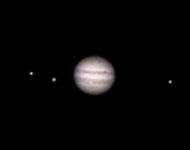
Though Jupiter is not the closest planet to Earth, it is the king of planets with respect to size and so you’ll get to observe more details of Jupiter through telescope eyepieces than with your naked eye. The detail you see will depend on your telescope’s capacity but also on the observational conditions at the time. When viewing Jupiter through telescope types, particularly ones best suited for viewing planets, you should see several cloud bands made up of zones (lighter bands) and belts (darker bands) running parallel to the equator from north to south.


Jupiter has an apparent diameter of 45 arcseconds. Jupiter through telescope: what are you likely to see? Such storms on Jupiter rage for hours, weeks, or even centuries and can generate wind speeds of up to 100 miles per second. Visible since the early 19 th century, Jupiter’s Great Red Spot as seen from Earth is really a massive storm (bigger than Earth itself!) that rotates clockwise.

Jupiter has moons, rings, and clouds (as covered below), but the most distinctive feature of the planetary king of our solar system is the Great Red Spot. If you own a telescope you may be wondering what magnification works best for observing Jupiter and what features are you likely to see? Moons? Rings? The Great Red Spot? You know how great Jupiter looks through the eyes of NASA, but what about Jupiter through telescope types available to you… Beautiful image of Jupiter and it’s four Galilean moonsįrom music and the arts to its place in the solar system, as the biggest solar system planet, Jupiter has always conveyed magnitude and majesty.


 0 kommentar(er)
0 kommentar(er)
